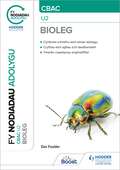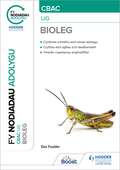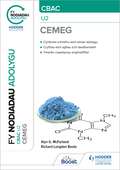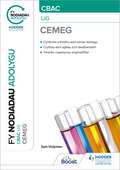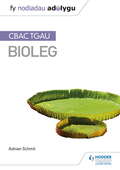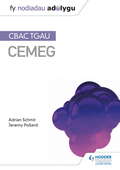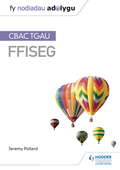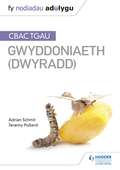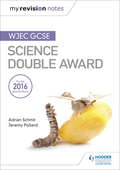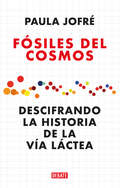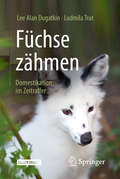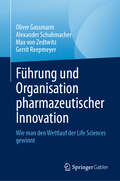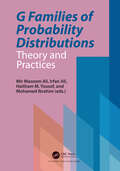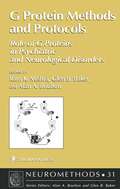- Table View
- List View
Fy Nodiadau Adolygu: CBAC Bioleg U2 (My Revision Notes: WJEC/Eduqas A-Level Year 2 Biology)
by Dan FoulderTarget exam success with My Revision Notes.Our updated approach to revision will help you learn, practise and apply your skills and understanding. Coverage of key content from Year 2 is combined with practical study tips and effective revision strategies to create a guide you can rely on to build both knowledge and confidence.My Revision Notes: WJEC/Eduqas A-level Biology will help you:- Develop your subject knowledge by making links between topics for more in-depth exam answers- Practise and apply your skills and knowledge with exam-style questions and frequent 'Now Test Yourself' questions with answer guidance online- Improve maths skills with helpful reminders and tips accompanied by worked examples- Avoid common mistakes and enhance your exam answers with 'Examiner tips'- Build quick recall with bullet-pointed summaries at the end of each chapter- Understand key terms you will need for the exam with user-friendly definitions and a glossary- Plan and manage your revision with our topic-by-topic planner and exam breakdown introduction
Fy Nodiadau Adolygu: CBAC Bioleg UG (My Revision Notes: WJEC/Eduqas AS/A-Level Year 1 Biology)
by Dan FoulderTarget exam success with My Revision Notes.Our updated approach to revision will help you learn, practise and apply your skills and understanding. Coverage of key content from Year 1 is combined with practical study tips and effective revision strategies to create a guide you can rely on to build both knowledge and confidence.My Revision Notes: WJEC/Eduqas AS/A-level Biology will help you:· Develop your subject knowledge by making links between topics for more in-depth exam answers· Practise and apply your skills and knowledge with exam-style questions and frequent 'Now Test Yourself' questions with answer guidance online· Improve maths skills with helpful reminders and tips accompanied by worked examples· Avoid common mistakes and enhance your exam answers with 'Examiner tips'· Build quick recall with bullet-pointed summaries at the end of each chapter· Understand key terms you will need for the exam with user-friendly definitions and a glossary· Plan and manage your revision with our topic-by-topic planner and exam breakdown introduction
Fy Nodiadau Adolygu: CBAC Bioleg UG (My Revision Notes: WJEC/Eduqas AS/A-Level Year 1 Biology)
by Dan FoulderTarget exam success with My Revision Notes.Our updated approach to revision will help you learn, practise and apply your skills and understanding. Coverage of key content from Year 1 is combined with practical study tips and effective revision strategies to create a guide you can rely on to build both knowledge and confidence.My Revision Notes: WJEC/Eduqas AS/A-level Biology will help you:· Develop your subject knowledge by making links between topics for more in-depth exam answers· Practise and apply your skills and knowledge with exam-style questions and frequent 'Now Test Yourself' questions with answer guidance online· Improve maths skills with helpful reminders and tips accompanied by worked examples· Avoid common mistakes and enhance your exam answers with 'Examiner tips'· Build quick recall with bullet-pointed summaries at the end of each chapter· Understand key terms you will need for the exam with user-friendly definitions and a glossary· Plan and manage your revision with our topic-by-topic planner and exam breakdown introduction
Fy Nodiadau Adolygu: CBAC Cemeg U2 (My Revision Notes: CBAC/Eduqas A-Level Year 2 Chemistry)
by Alyn G. McFarland Richard BooleTarget exam success with My Revision Notes. Our updated approach to revision will help you learn, practise and apply your skills and understanding. Coverage of key content is combined with practical study tips and effective revision strategies to create a guide you can rely on to build both knowledge and confidence.My Revision Notes: WJEC/Eduqas A-level Chemistry will help you:- Develop your subject knowledge by making links between topics for more in-depth exam answers- Practise and apply your skills and knowledge with exam-style questions and frequent 'Now Test Yourself' questions with answer guidance online- Improve maths skills with helpful reminders and tips accompanied by worked examples- Avoid common mistakes and enhance your exam answers with 'Examiner tips'- Build quick recall with bullet-pointed summaries at the end of each chapter- Understand key terms you will need for the exam with user-friendly definitions and a glossary- Plan and manage your revision with our topic-by-topic planner and exam breakdown introduction
Fy Nodiadau Adolygu: CBAC Cemeg U2 (My Revision Notes: CBAC/Eduqas A-Level Year 2 Chemistry)
by Alyn G. McFarland Richard BooleTarget exam success with My Revision Notes. Our updated approach to revision will help you learn, practise and apply your skills and understanding. Coverage of key content is combined with practical study tips and effective revision strategies to create a guide you can rely on to build both knowledge and confidence.My Revision Notes: WJEC/Eduqas A-level Chemistry will help you:- Develop your subject knowledge by making links between topics for more in-depth exam answers- Practise and apply your skills and knowledge with exam-style questions and frequent 'Now Test Yourself' questions with answer guidance online- Improve maths skills with helpful reminders and tips accompanied by worked examples- Avoid common mistakes and enhance your exam answers with 'Examiner tips'- Build quick recall with bullet-pointed summaries at the end of each chapter- Understand key terms you will need for the exam with user-friendly definitions and a glossary- Plan and manage your revision with our topic-by-topic planner and exam breakdown introduction
Fy Nodiadau Adolygu: CBAC Cemeg UG (My Revision Notes: WJEC/Eduqas AS/A-Level Year 1 Chemistry)
by Sam HolymanTarget exam success with My Revision Notes.Our updated approach to revision will help you learn, practise and apply your skills and understanding. Coverage of key content in Year 1 is combined with practical study tips and effective revision strategies to create a guide you can rely on to build both knowledge and confidence.My Revision Notes: WJEC/Eduqas AS/A-level Chemistry will help you:· Develop your subject knowledge by making links between topics for more in-depth exam answers· Practise and apply your skills and knowledge with exam-style questions and frequent 'Now Test Yourself' questions with answer guidance online· Improve maths skills with helpful reminders and tips accompanied by worked examples· Avoid common mistakes and enhance your exam answers with 'Examiner tips'· Build quick recall with bullet-pointed summaries at the end of each chapter· Understand key terms you will need for the exam with user-friendly definitions and a glossary· Plan and manage your revision with our topic-by-topic planner and exam breakdown introduction
Fy Nodiadau Adolygu: CBAC Cemeg UG (My Revision Notes: WJEC/Eduqas AS/A-Level Year 1 Chemistry)
by Sam HolymanTarget exam success with My Revision Notes.Our updated approach to revision will help you learn, practise and apply your skills and understanding. Coverage of key content in Year 1 is combined with practical study tips and effective revision strategies to create a guide you can rely on to build both knowledge and confidence.My Revision Notes: WJEC/Eduqas AS/A-level Chemistry will help you:· Develop your subject knowledge by making links between topics for more in-depth exam answers· Practise and apply your skills and knowledge with exam-style questions and frequent 'Now Test Yourself' questions with answer guidance online· Improve maths skills with helpful reminders and tips accompanied by worked examples· Avoid common mistakes and enhance your exam answers with 'Examiner tips'· Build quick recall with bullet-pointed summaries at the end of each chapter· Understand key terms you will need for the exam with user-friendly definitions and a glossary· Plan and manage your revision with our topic-by-topic planner and exam breakdown introduction
Fy Nodiadau Adolygu: CBAC TGAU Bioleg (My Revision Notes)
by Adrian SchmitTarget success in Science with this proven formula for effective, structured revision; key content coverage is combined with exam-style tasks and practical tips to create a revision guide that students can rely on to review, strengthen and test their knowledge.With My Revision Notes, every student can:- Plan and manage a successful revision programme using the topic-by-topic planner- Consolidate subject knowledge by working through clear and focused content coverage- Test understanding and identify areas for improvement with regular 'Now Test Yourself' tasks and answers- Improve exam technique through practice questions, expert tips and examples of typical mistakes to avoid- Get exam ready with extra quick quizzes and answers to the practice questions available online
Fy Nodiadau Adolygu: CBAC TGAU Cemeg (My Revision Notes: WJEC GCSE Chemistry, Welsh-language Edition)
by Jeremy Pollard Adrian SchmitTarget success in Science with this proven formula for effective, structured revision; key content coverage is combined with exam-style tasks and practical tips to create a revision guide that students can rely on to review, strengthen and test their knowledge.With My Revision Notes, every student can:- Plan and manage a successful revision programme using the topic-by-topic planner- Consolidate subject knowledge by working through clear and focused content coverage- Test understanding and identify areas for improvement with regular 'Now Test Yourself' tasks and answers- Improve exam technique through practice questions, expert tips and examples of typical mistakes to avoid- Get exam ready with extra quick quizzes and answers to the practice questions available online
Fy Nodiadau Adolygu: CBAC TGAU Ffiseg (My Revision Notes: WJEC GCSE Physics, Welsh-language Edition)
by Jeremy PollardTarget success in Science with this proven formula for effective, structured revision; key content coverage is combined with exam-style tasks and practical tips to create a revision guide that students can rely on to review, strengthen and test their knowledge.With My Revision Notes, every student can:- Plan and manage a successful revision programme using the topic-by-topic planner- Consolidate subject knowledge by working through clear and focused content coverage- Test understanding and identify areas for improvement with regular 'Now Test Yourself' tasks and answers- Improve exam technique through practice questions, expert tips and examples of typical mistakes to avoid- Get exam ready with extra quick quizzes and answers to the practice questions available online
Fy Nodiadau Adolygu: CBAC TGAU Gwyddoniaeth Dwyradd (My Revision Notes: WJEC GCSE Science Double Award, Welsh-language Edition)
by Jeremy Pollard Adrian SchmitTarget success in Science with this proven formula for effective, structured revision; key content coverage is combined with exam-style tasks and practical tips to create a revision guide that students can rely on to review, strengthen and test their knowledge.With My Revision Notes, every student can:- Plan and manage a successful revision programme using the topic-by-topic planner- Consolidate subject knowledge by working through clear and focused content coverage- Test understanding and identify areas for improvement with regular 'Now Test Yourself' tasks and answers- Improve exam technique through practice questions, expert tips and examples of typical mistakes to avoid- Get exam ready with extra quick quizzes and answers to the practice questions available online
Fy Nodiadau Adolygu: WJEC GCSE Biology Welsh Edition Epub (My Revision Notes)
by Adrian SchmitTarget success in Science with this proven formula for effective, structured revision; key content coverage is combined with exam-style tasks and practical tips to create a revision guide that students can rely on to review, strengthen and test their knowledge. With My Revision Notes, every student can:- Plan and manage a successful revision programme using the topic-by-topic planner- Consolidate subject knowledge by working through clear and focused content coverage- Test understanding and identify areas for improvement with regular 'Now Test Yourself' tasks and answers- Improve exam technique through practice questions, expert tips and examples of typical mistakes to avoid- Get exam ready with extra quick quizzes and answers to the practice questions available online
Fy Nodiadau Adolygu: WJEC GCSE Physics, Welsh-language Edition)
by Jeremy PollardExam Board: WJECLevel: GCSESubject: PhysicsFirst Teaching: September 2016First Exam: Summer 2018Target success in Science with this proven formula for effective, structured revision; key content coverage is combined with exam-style tasks and practical tips to create a revision guide that students can rely on to review, strengthen and test their knowledge.With My Revision Notes, every student can:- Plan and manage a successful revision programme using the topic-by-topic planner- Consolidate subject knowledge by working through clear and focused content coverage- Test understanding and identify areas for improvement with regular 'Now Test Yourself' tasks and answers- Improve exam technique through practice questions, expert tips and examples of typical mistakes to avoid- Get exam ready with extra quick quizzes and answers to the practice questions available onlinePlease note that some of the quizzes from the WJEC GCSE My Revision Notes series are also used in the WJEC GCSE Teaching and Learning resources.
Fy Nodiadau Adolygu: WJEC GCSE Science Double Award, Welsh-language Edition)
by Jeremy Pollard Adrian SchmitExam Board: WJECLevel: GCSESubject: ScienceFirst Teaching: September 2016First Exam: Summer 2018Target success in Science with this proven formula for effective, structured revision; key content coverage is combined with exam-style tasks and practical tips to create a revision guide that students can rely on to review, strengthen and test their knowledge.With My Revision Notes, every student can:- Plan and manage a successful revision programme using the topic-by-topic planner- Consolidate subject knowledge by working through clear and focused content coverage- Test understanding and identify areas for improvement with regular 'Now Test Yourself' tasks and answers- Improve exam technique through practice questions, expert tips and examples of typical mistakes to avoid- Get exam ready with extra quick quizzes and answers to the practice questions available onlinePlease note that some of the quizzes from the WJEC GCSE My Revision Notes series are also used in the WJEC GCSE Teaching and Learning resources.
Fylling's Illustrated Guide to Nature in Your Neighborhood
by Marni FyllingThe acclaimed author and science illustrator presents an engaging and enlightening guide to the bizarre and surprising wildlife all around us.In the same lighthearted yet scientifically accurate style of Fylling’s Illustrated Guide to Pacific Coast Tide Pools, this compact guidebook reveals the splendidly strange animals and plants just outside your door. Marni Fylling’s full-color illustrations make species identification a snap, and concise descriptions include fascinating (and sometimes grotesque) factoids about frequently encountered plants, insects, arachnids, birds, and mammals. With Fylling’s guidance, the everyday becomes extraordinary: Pigeons share nest-building and egg-sitting duties, and mate for life—with occasional dalliances; squirrel teeth grow about six inches per year; spiders owe their characteristic creep to their “hydraulic” legs; poison oak and poison ivy’s itch-inducing oil is also found in pistachios, cashews, and mangoes; and much, much more.
Fälscher, Schwindler, Scharlatane: Betrug in Forschung und Wissenschaft (Erlebnis Wissenschaft)
by Heinrich ZanklJetzt als Sonderausgabe! Kennen Sie den Mogelfaktor? Gibt es diesen etwa auch in der hehren Forschung? Ja, und er perfektionierte beispielsweise die Ergebnisse vom ehrenwehrten Sir Isaac Newton. Er kreierte auch Laborbuchnotizen für den Kardiologen Darsee und transferierte auf magische Weise Bakterienstämme von einem Universitätslabor in das Labor der Firma Genentech. Selbst fiktive Mitarbeiterinnen erschuf der Mogelfaktor, die für den Zwillingsforscher Cyril Burt ebenso fiktive Zwillingsstudien durchführten; und diese beeinflussten noch jahrelang die Intelligenzforschung auf der ganzen Welt! Heinrich Zankl hat alte und neue Skandale in den Geistes- und Naturwissenschaften überzeugend recherchiert und zu einem Geflecht aus wertvoller Information und guter Unterhaltung verwoben. Dieses Buch erzählt viele Geschichten, beispielsweise die eines Nobelpreises, der an die Falschen verliehen wurde, von der Unterdrückung von Kritikern und sogar von einem Wissenschaftsbetrüger, der vom Bundesverfassungsgericht geschützt wird. Manche Aspekte sind dabei so grotest, dass sich kein Leser das Schmunzeln verkneifen kann. Ein Lesevergnügen, nicht nur für Wissenschaftler.
Física de lo imposible
by Michio KakuDesde el tele transporte hasta la telequinesia, Michio Kaku acude al mundo de la ciencia ficción para explorar las premisas y los límites de las leyes de la física que aceptamos hoy día. En una obra atractiva y provocadora, Kaku explica, por ejemplo, cómo la ciencia óptica y el electromagnetismo permitirán algún día que la luz rodee un objeto, haciéndolo invisible; cómo nuevos cohetes, velas de láser, motores de antimateria y nanocohetes pueden acercarnos a las estrellas más cercanas; cómo la telepatía y la telequinesia, antes despreciadas como pseudociencia, pueden lograrse gracias a resonancias magnéticas, ordenadores, superconductores y nanotecnología. El resultado es una extraordinaria aventura científica, que lleva a los lectores a un viaje inolvidable por los confines de la ciencia.
Física de lo imposible: ¿Podremos ser invisibles, viajar en el tiempo y teletransportarnos?
by Michio Kaku¿Hasta qué punto los ingenios de la ciencia ficción que hoy consideramos imposibles pueden ser habituales en el futuro? Teletransporte, máquinas del tiempo, campos de fuerza y naves intergalácticas: ¿materia de ciencia ficción o tecnologías potencialmente disponibles en el futuro? Inspirado por los mundos fantásticos de H.G. Wells, Star Trek o La guerra de las galaxias, el prestigioso físico teórico y divulgador Michio Kaku lanza una mirada inteligente, seria y a menudo sorprendente a lo que nuestra actual comprensión de las leyes del universo nos permite vislumbrar en el futuro. Un fascinante viaje por mundos hasta ahora solo soñados por la ciencia ficción, que ofrece nuevos retos a las próximas generaciones de científicos capaces de desafiar las imposibilidades de nuestro tiempo. Reseñas:«Física de lo imposible trata de explicar por qué algunas visiones del futuro podrían llegar a realizarse mientras que otras probablemente permanecerán más allá de los límites de lo posible [...] La ciencia ficción explora a menudo estas cuestiones; la ciencia en cambio permanece callada en este punto. El trabajo de Kaku ayuda a llenar un vacío.»The Economist «Aquello que muchos consideran un vuelo de la imaginación se está materializando gracias a recientes descubrimientos científicos, que van desde tímidos progresos en teletransporte hasta la creación de pequeñas cantidades de antimateria y transmisiones más rápidas que la velocidad de la luz. Kaku demuestra que en los maravillosos mundos de la ciencia las cosas imposibles suceden a diario.»Publishers Weekly «Pocos físicos teóricos se plantearían explorar algunas de estas posibles imposibilidades, y hay que felicitar a Kaku por hacerlo. Es un excelente estímulo intelectual.»Los Angeles Times
Fósiles del cosmos
by Paula Jofré PfeilUna importante contribución a la ciencia astronómica. Un viaje que comienza con la composición química de nuestra galaxia y que, a través de la misión espacial GAIA, nos muestra la forma en que ha evolucionado el universo. La astronomía ha logrado llevar a cabo, nos dice Paula Jofré en este libro, un progreso sin parangón en los últimos años. La misión espacial GAIA, punta de lanza del programa científico de la Agencia Espacial Europea, ha posibilitado el acceso a información de incalculable valor: el lugar y la distribución de millones de estrellas que conforman nuestra galaxia. La ciencia galáctica, compuesta por conocimientos tan distintos como la física nuclear, la estadística, la astrofísica y la inteligencia artificial, entre otras áreas del saber, ha posibilitado un proyecto interdisciplinario fundamental para entender los datos que GAIA, desde el espacio, puede ofrecer. En Fósiles del cosmos, la autora nos introduce tanto en la astronomía, como en la composición química estelar, en el funcionamiento de las estrellas, la posición de las estrellas en el cielo, en las historias de las científicas que han hecho historia en esta área del saber y, sobre todo, nos enseña a leer y comprender los mapas y datos que la misión espacial envía a la Tierra, ofreciendo una nueva manera de comprensión del cosmos y, sobre todo, la posición que ocupamos en este. De esta forma se puede explicar, de manera certera, la formación y evolución de la Vía Láctea, nuestra galaxia…
Füchse zähmen
by Lee Alan Dugatkin Jorunn Wissmann Ludmila TrutAn einem Ort im abgelegenen Sibirien findet man vierbeinige Fellwesen, die mit dem Schwanz wedeln, Schlappohren haben und so gelehrig und freundlich sind wie Schoßhunde. Doch es sind keine Hunde – es sind Füchse. Sie sind das Ergebnis eines der erstaunlichsten Züchtungsexperimente, die je unternommen wurden – stellen Sie sich einmal vor, die Evolution mehrerer Jahrtausende sei auf einen Zeitraum weniger Jahrzehnte beschleunigt. Im Jahre 1959 nahmen sich die Biologen Dmitri Beljajew und Ludmila Trut genau dies vor, indem sie mit ein paar Dutzend Silberfüchsen von Pelzfarmen in der damaligen UdSSR begannen und mit ihnen die Entwicklung vom Wolf zum Hund in Echtzeit nachzuvollziehen versuchten, um so den Prozess der Domestikation direkt zu beobachten. Das vorliegende Buch erzählt die bisher weitgehend unbekannte Geschichte dieses bemerkenswerten Unterfangens. Die meisten Berichte über die natürliche Evolution des Wolfes legen dem Domestikationsprozess eine Zeitspanne von 15.000 Jahren zugrunde, aber aus Beljajews und Truts Züchtungsexperimenten gingen schon innerhalb eines Jahrzehnts welpenähnliche Füchse mit Schlappohren, gesprenkelten Fellen und gebogenen Schwänze hervor. Begleitet wurden diese physischen Veränderungen von genetischen und Verhaltens-Modifikationen. Für die Züchtung der Füchse war Zahmheit das entscheidende Selektionskriterium, und mit jeder Generation zeigten die Tiere ein zunehmend größeres Interesse an der Gemeinschaft mit Menschen. Trut ist seit Anfang an bei diesen Experimenten dabei, und nach Beljajews Tod im Jahre 1985 übernahm sie die Leitung. Zusammen mit dem Biologen und Wissenschaftsautor Lee Dugatkin erzählt sie hier nun die Geschichte dieses Abenteuers und der Wissenschaft, Politik und Liebe dahinter. In Füchse zähmen nehmen uns Dugatkin und Trut mit auf die Innenseite dieses bahnbrechenden Experiments inmitten der brutalen sibirischen Winter und legen offen, wie Wissenschaftsgeschichte gemacht wird – bis heute. Inzwischen sind 58 Generationen von Füchsen domestiziert, und immer noch lernen wir von ihnen bedeutsame Dinge über die genetische und verhaltensbiologische Evolution domestizierter Tiere. Füchse zähmen bietet eine oft unglaubliche Geschichte von Wissenschaftlern bei der Arbeit und ist zugleich eine Hommage an die tiefen Bande, die Tiere und Menschen über alle Zeiten hinweg entwickelt haben. Stimmen zur amerikanischen Originalausgabe Vor über 60 Jahren entschlossen sich die russischen Forscher [Ludmila] Trut und Dmitri Beljajew, wilde Füchse zu domestizieren, um im Detail herauszufinden, wie die Reise vom Wildtier zum Haustier abläuft. Sie setzten ihr Experiment in einer Pelzfarm in Sibirien auf und wählten über die folgenden Jahrzehnte stets die zahmsten Tiere jeder Generation für die weitere Fortpflanzung aus. In diesem Buch zeichnen der Biologe und Wissenschaftsautor Dugatkin und Trut die Geschichte dieses großartigen Experiments nach. Das Ergebnis sind eine Schar gelehriger Füchse und die Entschlüsselung der genetischen Grundlagen ihrer Domestikation. Scientific American Schillernd … Eine Geschichte, die teils Wissenschaft, teils russisches Märchen, teils Spionagethriller ist … Die Ergebnisse sind selbst unter Wissenschaftlern, geschweige denn in der Öffentlichkeit, viel weniger bekannt, als sie es verdient haben. New York Times Dugatkin ist ein sehr erfahrener Wissenschaftsautor mit der besonderen Gabe, vielfach verzweigte Themen in kompakte, unterhaltsame Geschichten zu verwandeln. Frau Trut, inzwischen in ihren Achtzigern, ist gleichermaßen Coautorin und Gegenstand des Buches … ihre intensive Mitwirkung verleiht diesem Wissenschaftsbericht eine seltene Form der Intimität. Wall Street Journal Ein zauberhafter Bericht … Nach etwa 20 Generationen wurden die gezähmten Füchse immer mehr wie Hunde: loyal und unschlagbar niedlich. New Scientist Voller Zuneigung erzählen uns Trut und Dugatkin von den Meilensteinen des Experiments, von dem ersten neugeborenen Fuchs, der mit dem Schwanz wedelte, und von dem ersten mit Schlappohren … Bei jedem Schritt verweben die Autoren in geschickter W
Fügetechnologie Kleben: eine Anleitung für den zeitgemässen und sicheren Klebprozess in Industrie und Handwerk
by Jürgen KlingenKleben gehört zu den wärmearmen Fügetechniken und ist in der Lage, praktisch alle technisch nutzbaren Werkstoffe miteinander und untereinander flächig und stoffschlüssig zu verbinden. Die hierbei durch Adhäsion entstehende Verbindung wird sehr schonend aufgebaut, da der Klebvorgang weder großer Hitze (wie beim Schweißen oder Löten), noch strukturschwächende Löcher (wie beim Nieten oder Schrauben) bedarf. Die in der Regel großflächig ausgelegte Klebung sorgt zudem für eine relativ gleichmäßige Spannungsverteilung im Bauteil. In einem klar strukturierten 5-Phasensystem bietet Fügetechnologie Kleben hier eine detaillierte Anleitung für die Schritte, die für den Aufbau eines sicheren und stabilen Klebprozesses zur Herstellung eines qualitativ hochwertigen Bauteils notwendig sind. Berücksichtigt werden dabei unter anderem die Vorbehandlung der zu verklebenden Werkstoff oberflächen, die Auswahl der geeigneten Klebstoffe, die Dimensionierung der Verklebung sowie die Prozessschritte zur Dosierung beziehungsweise Aushärtung der Klebstoffe. Dem Anwender werden so moderne und nachhaltige Materialien sowie klebtechnische Verfahren präsentiert, mit einem besonderen Fokus auf Oberflächenbehandlungsmöglichkeiten, Klebstoffe und Verarbeitungsmethoden relevant für Industrie und Handwerk.
Führung und Organisation pharmazeutischer Innovation: Wie man den Wettlauf der Life Sciences gewinnt
by Alexander Schuhmacher Oliver Gassmann Gerrit Reepmeyer Max von ZedtwitzDieses Buch untersucht und beleuchtet die wichtigsten Herausforderungen, denen sich die pharmazeutische Industrie in einem zunehmend wettbewerbsorientierten Umfeld mit inflationären F&E-Investitionen und verschärftem Kostendruck stellen muss. Die Autoren stellen drei Quellen der pharmazeutischen Innovation vor: neue Managementmethoden in der Arzneimittelentwicklung, neue Technologien als Voraussetzung für Spitzenforschung und -entwicklung und neue Formen der Zusammenarbeit und Internationalisierung, wie z. B. Open Innovation in den frühen Phasen der Forschung und Entwicklung. Neue Modelle und Methoden werden anhand von Fallbeispielen aus Europa, den USA und Asien illustriert. Diese dritte, vollständig überarbeitete Auflage wurde erweitert, um die neuesten Entwicklungen im Bereich der offenen und kollaborativen Innovation, die größere strategische Bedeutung von Risikokapital und Investitionen in der Frühphase sowie die neue Palette an aufkommenden Technologien, die jetzt in der pharmazeutischen Innovation eingesetzt werden, zu berücksichtigen.
Für alles eine App: Ideen für Physik mit dem Smartphone
by Jochen Kuhn Thomas WilhelmFür alles eine AppWelche Apps eignen sich, um Smartphone oder Tablet für physikalische Untersuchungen und Betrachtungen zu nutzen? Diese Frage stellen sich physikalisch Interessierte genauso wie Lehrkräfte. Dieses Buch gibt einen schnellen und umfassenden Überblick über geeignete Apps und stellt anhand vieler Praxisbeispiele dar, wie man Smartphone und Tablet physikalisch nutzen kann.Die Autorinnen und Autoren gehen auf unterschiedlichste Anwendungen ein: Sie reichen von vorgefertigten Simulationen über physikalische Spiele bis hin zu Augmented Reality-Anwendungen, bei denen virtuelle Objekte in das Bild der realen Welt eingeblendet werden. Zudem werden Apps vorgestellt, mit denen Messdaten mit den internen Sensoren oder externen Zusatzgeräten erfasst, von einer Datenbank abgerufen oder durch die Verwendung der Foto- und Videokamera gewonnen werden.In jedem einzelnen Abschnitt wird eine andere App kurz und überblicksweise vorgestellt und deren Verwendbarkeit für physikalische Untersuchungen in Schule und/oder Hochschule und/oder zur eigenen Unterhaltung an einem Beispiel erläutert. Zunächst gibt es eine App-Kurzbeschreibung und Informationen zu Technik und Handhabung. Es folgt die Beschreibung eines physikalischen Anwendungsbeispiels. Die Abschnitte sind nach klassischen Themenbereichen der Physik geordnet.Die Leserinnen und Leser werden nach der Lektüre• einen Überblick haben, welche vielfältigen physikalischen Anwendungen mit mobilen Geräten möglich sind,• viele verschiedene Apps kennengelernt haben,• zu physikalischen Spielereien mit mobilen Geräten motiviert sein,• Anregungen kennen, wie man mobile Endgeräte in der physikalischen Lehre einsetzen kann.
G Families of Probability Distributions: Theory and Practices
by Mohamed Ibrahim Mir Masoom Ali Irfan Ali Haitham M. YousofStatistical distributions are essential tools to model the characteristics of datasets, such as right or left skewness, bi-modality or multi-modality observed in different applied sciences, such as engineering, medicine, and finance. The well-known distributions like normal, Weibull, gamma and Lindley are extensively used because of their simple forms and identifiability properties. In the last decade, researchers have focused on the more complex and flexible distributions, referred to as Generalized or simply G families of probability distributions, to increase the modelling capability of these distributions by adding one or more shape parameters.The main aim of this edited book is to present new contributions by researchers in the field of G families of probability distributions. The book will help researchers to: Develop new univariate continuous and discrete G families of probability distributions. Develop new bivariate continuous and discrete G families of probability distributions. Derive beneficial mathematical properties such as ordinary and incomplete moments, moment generating functions, residual life and reversed residual life functions, order statistics, quantile spread ordering and entropies, and some bivariate and multivariate extensions of the new and existing models using a simple-type copula.
G Protein Methods and Protocols
by Alan A. Boulton Glen B. Baker Ram K. MishraCombining the cutting-edge insights of leading basic and clinical investigators, G Protein Methods and Protocols provides both critical reviews and detailed protocols for studying the medical role played by G proteins and cellular signaling in psychiatric and neurological disease. The mental and neurological disorders covered range from Parkinson's disease and schizophrenia to manic depression, drug addiction, and mood and anxiety disorders.
